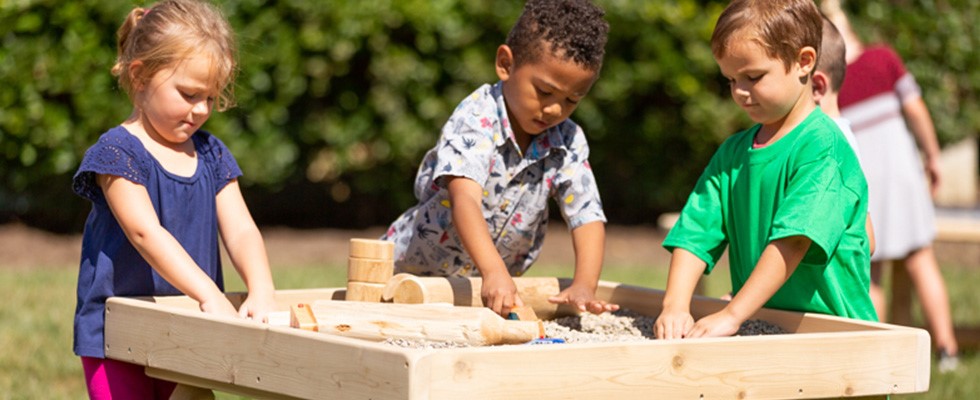
In recent years, toddler sensory tables have become a favorite classroom learning tool among educators. It can be tough to find a single product that works both indoors and outdoors, provides interesting tactile stimulation, and promotes toddler development. But toddler and early learning sensory tables offer all of the above. The only real question is knowing which model is right for your classroom.
Today, we're sharing valuable insights you need to know to purchase the best toddler sensory tables for your space.
1. Safety features are a top priority
As you explore the wide variety of toddler sensory tables on the market right now, narrow down your selection by focusing on safety. Look for sensory tables with rounded edges, sturdy construction, and non-toxic materials, ensuring the safety of toddlers during play. Some products may also have certain safety endorsements to consider, as well, with recommended adult supervision or highlighted pieces that could present as choke hazards.
2. Size and height characteristics to consider
Table size and variable heights are important considerations when you're outfitting a room for 2 and 3-year-olds versus rooms with 5 and 6-year-olds. Choose a sensory table that is the appropriate size and height for your students to comfortably reach in and explore the contents of without straining or stretching to do so. And be sure the table fits your overall space requirements.
3. Durability for extended and frequent use
Look for a sensory table made from durable materials that can easily withstand frequent use and rough handling by active toddlers. Many are made from durable plastic or attractive Baltic Birch with a UV finish that prevents fading.
4. Easy to Clean Surfaces and Materials
Select toddler sensory tables with surfaces that are easy to wipe clean and sanitize to maintain hygiene standards in your daycare center or classroom. Disinfection between uses is critical for early learning spaces. So, consider soft PBA-free plastics or Baltic Birch in lieu of other materials that may be harder to clean effectively.
5. Look for toddler sensory tables with multi-sensory activities
Consider sensory tables that offer a variety of sensory experiences. Some of these might include water play, sand play, light exploration, and color mixing to engage toddlers in diverse sensory learning opportunities. Some also offer audible stimulations to complement the tactile and visual engagements.
6. Choose sensory tables with accessibility
Ensure that the sensory table is accessible to all your participating toddlers, including those with mobility challenges or disabilities. Do so by choosing models with adjustable height options, or by incorporating additional seating arrangements.
7. Identify products with storage options
Look for sensory tables with built-in storage compartments or shelves to keep sensory materials, toys, and accessories organized. These built-in options are convenient for educators and make extra tools and toys easily accessible for students.
8. Portability for indoor and outdoor Use
Consider the portability of the sensory table, especially if you plan to use your tables in multiple locations or outdoor settings. And choose toddler sensory tables with lightweight construction and easy-to-move or collapsable features.
9. Activities for various developmental stages
Select sensory tables that your toddlers and young learners call all use and grow with over time. Find models that can be used for a variety of activities and learning experiences beyond sensory play, too. These might include art projects, science experiments, and imaginative play to maximize the educational value and versatility for fun across different ages and developmental stages.
10. Budget considerations
Determine your budget and explore sensory table options within your price range. Prices vary considerably. But no matter the cost, it's an investment in your young students that will yield benefits for years to come.
FAQs About the best toddler sensory tables
Have more questions about how to choose the best toddler sensory tables for your classrooms or centers? Explore these quick-reference FAQs and answers to help!
What age is appropriate for a sensory table?
Toddler sensory tables come in a variety of sensory designs, offering fun and developmental benefits for children as young as one up to six or seven years old
What activities should your toddler sensory tables have?
Look for toddler sensory tables that feature a host of visual and tactile stimulation activities. Look for sorting games and opportunities to explore new textures. The best designs are durable and provide visual, tactile, and audible learning experiences.
How can your school buy modern toddler sensory tables today?
Find an early learning furniture partner like School Outfitters with experts who can help you explore all the best toddler sensory tables and place orders efficiently and within budget.
School Outfitters can help you find the best toddler sensory tables
With these insights, youÆre ready to purchase the best toddler sensory tables for your school, daycare, or learning center. And School Outfitters can help! Contact us about toddler sensory tables and any other school furniture you need for your sensory learning spaces!
Have questions? We're here to help! Our experts are available by phone at 1-800-260-2776. You can also get personalized assistance through our or by emailing us. We're available Monday-Friday, 8am-7pm.


